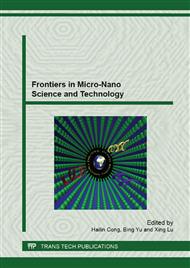[1]
T. Yang, D. Zhang, J. Ma, H. Ma and Y. Chen, Transparent conducting ZnO: Al films deposited on organic substrates deposited by r. f. magnetron-sputtering, Thin Solid Films 326 (1998) 60-62.
DOI: 10.1016/s0040-6090(98)00763-9
Google Scholar
[2]
P. Carcia, R. McLean, M. Reilly and G. Nunes, Transparent ZnO thin-film transistor fabricated by rf magnetron sputtering, Appl. Phys. Lett. 82 (2003) 1117-1119.
DOI: 10.1063/1.1553997
Google Scholar
[3]
S. Masuda, K. Kitamura, Y. Okumura, S. Miyatake, H. Tabata and T. Kawai, Transparent thin film transistors using ZnO as an active channel layer and their electrical properties, J. Appl. Phys. 93 (2003) 1624-1630.
DOI: 10.1063/1.1534627
Google Scholar
[4]
C. Magne, T. Moehl, M. Urien, M. Gratzel and T. Pauporte, Effects of ZnO film growth route and nanostructure on electron transport and recombination in dye-sensitized solar cells, J. Mater. Chem. A 1 (2013) 2079-(2088).
DOI: 10.1039/c2ta00674j
Google Scholar
[5]
P. Mitra, A. Chatterjee and H. Maiti, ZnO thin film sensor, Mater. Lett. 33 (1998) 33-38.
Google Scholar
[6]
M. Chougule, S. Sen and V. Patil, Fabrication of nanostructured ZnO thin film sensor for NO2 monitoring, Ceram. Int. 38 (2012) 2685-2692.
DOI: 10.1016/j.ceramint.2011.11.036
Google Scholar
[7]
H. Chen, Y. Liu, C. Xie, J. Wu, D. Zeng and Y. Liao, A comparative study on UV light activated porous TiO2 and ZnO film sensors for gas sensing at room temperature, Ceram. Int. 38 (2012) 503-509.
DOI: 10.1016/j.ceramint.2011.07.035
Google Scholar
[8]
J. Xu, Y. Yu, X. He, J. Sun, F. Liu and G. Lu, Synthesis of hierarchical ZnO orientation-ordered film by chemical bath deposition and its gas sensing properties, Mater. Lett. 81 (2012) 145-147.
DOI: 10.1016/j.matlet.2012.04.090
Google Scholar
[9]
L. Yang, R. Wang, S. Xu, Z. Xing, Y. Fan, X. Shi and B. Zhang, Effects of annealing temperature on the characteristics of Ga-doped ZnO film metal-semiconductor-metal ultraviolet photodetectors, J. Appl. Phys. 113 (2013) 084501.
DOI: 10.1063/1.4791760
Google Scholar
[10]
S. Jeong, J. Lee, S. Lee and J. Boo, Deposition of aluminum-doped zinc oxide films by RF magnetron sputtering and study of their structural, electrical and optical properties, Thin Solid Films 435 (2003) 78–82.
DOI: 10.1016/s0040-6090(03)00376-6
Google Scholar
[11]
S. Kuo, W. Chen, F. Lai, C. Cheng, H. Kuo, S. Wang and W. Hsieh, Effects of doping concentration and annealing temperature on properties of highly-oriented Al-doped ZnO films, J. Cryst. Growth 287 (2006) 78–84.
DOI: 10.1016/j.jcrysgro.2005.10.047
Google Scholar
[12]
C. Yang, Z. Ma, J. Yuan, Influence of substrate temperature on properties of aluminum-doped zinc oxide films prepared by DC magnetron sputtering, Acta. Opt. Sin. 31 (2011) 0531001 (in Chinese).
DOI: 10.3788/aos201131.0531001
Google Scholar
[13]
M. Agarwal, P. Modi and R. Dusane, Study of electrical, optical and structural properties of Al-doped ZnO thin films on PEN substrates, J. Nano-Electron. Phys. 5 (2013) 02027.
Google Scholar


